Solar plane's crossing of Pacific going smoothly (Update)
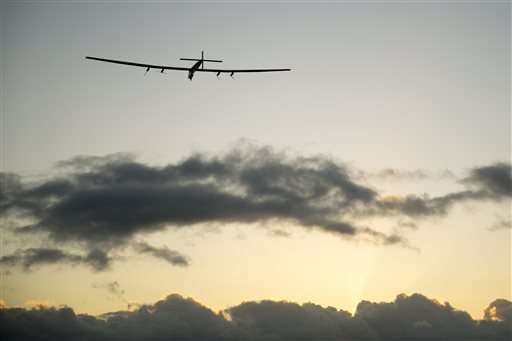
A solar-powered airplane on an around-the-world journey had traveled 80 percent of the way from Hawaii to California by Saturday morning.
The project's website says the Solar Impulse 2 aircraft is 48 hours into a three-day flight over the Pacific.
The aircraft's destination on this leg of the journey is Mountain View, California, at the southern end of San Francisco Bay.
The aircraft started its around-the-world journey in March 2015 from Abu Dhabi, the capital of the United Arab Emirates, and made stops in Oman, Myanmar, China and Japan. It's on the ninth leg of its circumnavigation.
In a live video feed on the website documenting the journey, pilot Bertrand Piccard and engineers on the ground discussed plans to fly over the Golden Gate Bridge before heading to Mountain View, where the plane is expected to land late Saturday.
"I don't know how many airplanes can hear that they still have 17 hours to go," Piccard said after being told he is expected to land about midnight. "It's good to have no fuel."
On Friday, he exchanged pleasantries with UN Secretary-General Ban Ki-moon, who hailed Piccard's pioneering spirit as "inspirational," telling him he was making history.
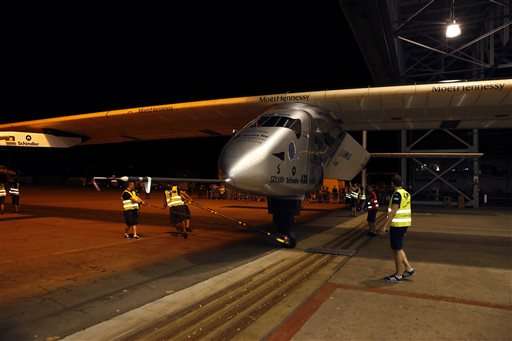
Piccard responded that Ban, too, was making history by having just presided over the signing of a climate agreement supported by representatives of 175 nations.
"What you are doing today in New York, signing the Paris agreement, is more than protecting the environment, it is the launch of the clean technology revolution," Piccard said.
The trans-Pacific leg of his journey is the riskiest part of the solar plane's global travels because of the lack of emergency landing sites.
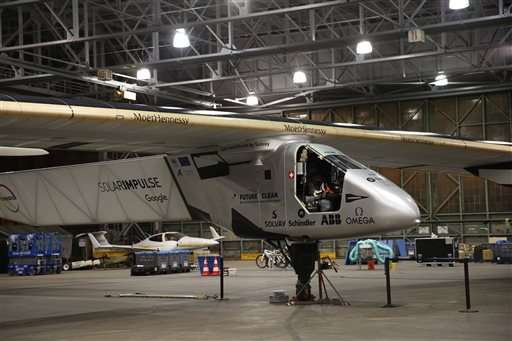
After uncertainty about winds, the plane took off from Hawaii on Thursday morning. The crew that helped it take off was clearing out of its Hawaiian hangar and headed for the mainland for the weekend arrival.
At one point passengers on a Hawaiian Air jet caught a glimpse of the Solar Impulse 2 before the airliner sped past the slow-moving aircraft.
The Solar Impulse 2 landed in Hawaii in July and was forced to stay in the islands after the plane's battery system sustained heat damage on its trip from Japan.
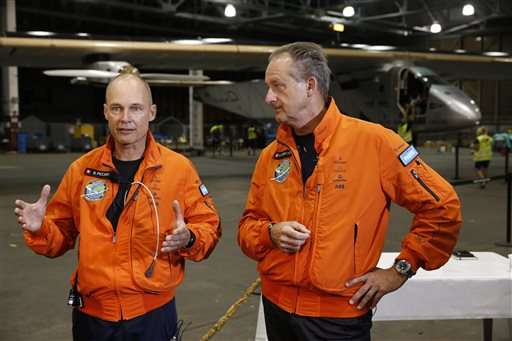
Piccard, said the destination in the heart of Silicon Valley is fitting, as the plane will land "in the middle of the pioneering spirit." Piccard's co-pilot Andre Borschberg flew the leg from Japan to Hawaii.
The team was delayed in Asia, as well. When first attempting to fly from Nanjing, China, to Hawaii, the crew had to divert to Japan because of unfavorable weather and a damaged wing.
A month later, when weather conditions were right, the plane departed from Nagoya in central Japan for Hawaii.
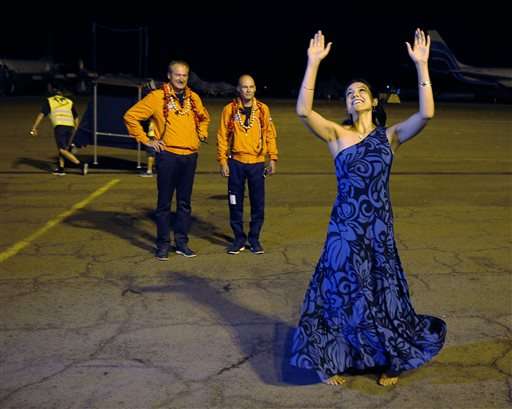
The plane's ideal flight speed is about 45 kph, or 28 mph, though that can double during the day when the sun's rays are strongest. The carbon-fiber aircraft weighs more than 5,000 pounds, or about as much as a midsize truck.
The wings of Solar Impulse 2, which stretch wider than those of a Boeing 747, are equipped with 17,000 solar cells that power propellers and charge batteries. The plane runs on stored energy at night.
-
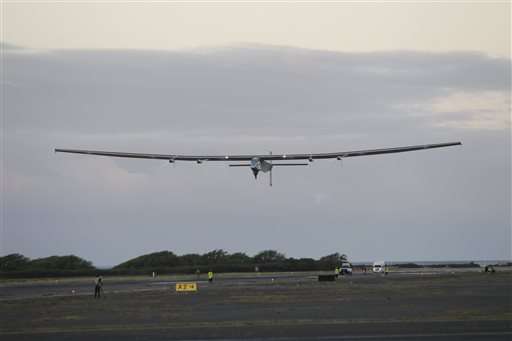
In this Thursday, April 21, 2016 file photo, the Solar Impulse 2 solar plane lifts off at the Kalaeloa Airport, in Kapolei, Hawaii. The solar plane on an around-the-world journey has reached the point of no return over the Pacific Ocean after departing Hawaii, and now it's California or bust. The plane was cruising over the cold northern Pacific late Thursday at about 20,000 feet with a nearly-full battery as night descended, according to the website that's documenting the journey of Solar Impulse 2. (AP Photo/Marco Garcia, File) -
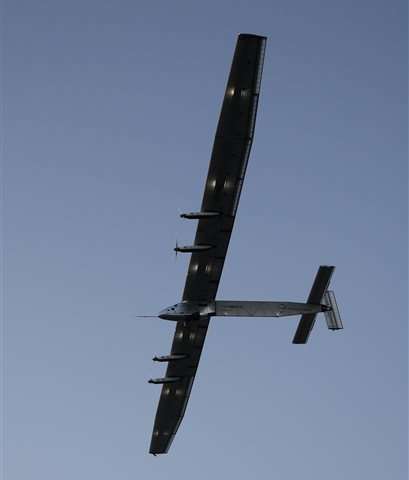
In this Thursday, April 21, 2016 file photo, the Solar Impulse 2 solar plane flies out of the Kalaeloa Airport, in Kapolei, Hawaii. The solar plane on an around-the-world journey has reached the point of no return over the Pacific Ocean after departing Hawaii, and now it's California or bust. The plane was cruising over the cold northern Pacific late Thursday at about 20,000 feet with a nearly-full battery as night descended, according to the website that's documenting the journey of Solar Impulse 2. (AP Photo/Marco Garcia, File) -
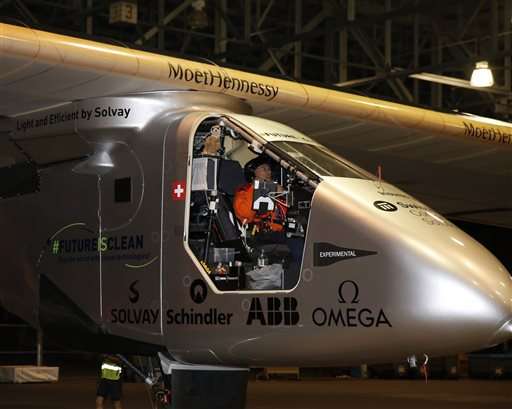
Solar Impulse 2 pilot Bertrand Piccard prepares to fly across the Pacific in a solar plane from Kalaeloa Airport, Thursday, April 21, 2016, in Kapolei, Hawaii. The solar plane will fly a two-and-a-half day journey to Northern California. (AP Photo/Marco Garcia) -
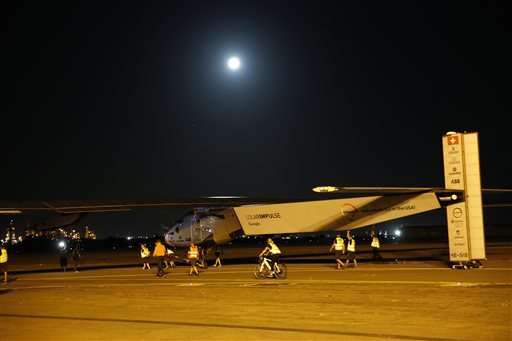
Ground crew pulls the Solar Impulse 2 solar plane on to the runway for a dawn lift off at Kalaeloa Airport, Thursday, April 21, 2016, in Kapolei, Hawaii. The solar plane will fly a two-and-a-half day journey to Northern California. (AP Photo/Marco Garcia) -
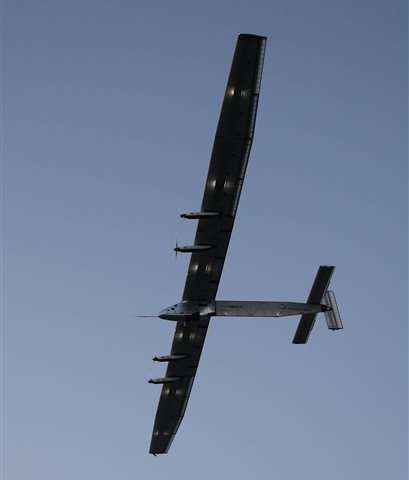
In this Thursday, April 21, 2016 file photo, the Solar Impulse 2 solar plane flies out of the Kalaeloa Airport, in Kapolei, Hawaii. The solar plane on an around-the-world journey has reached the point of no return over the Pacific Ocean after departing Hawaii, and now it's California or bust. The plane was cruising over the cold northern Pacific late Thursday at about 20,000 feet with a nearly-full battery as night descended, according to the website that's documenting the journey of Solar Impulse 2. (AP Photo/Marco Garcia, File)
© 2016 The Associated Press. All rights reserved.





















